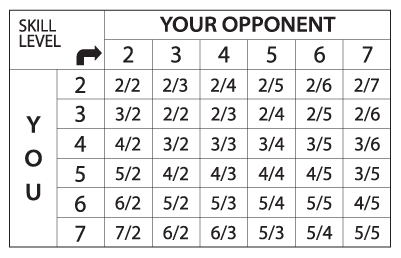Appearance
Using The BPPL Handicap System
How Handicaps are Determined
The BPPL calculates and reports skill levels to the teams on a regular basis. Your skill level determines how many frames you have to earn to win your match. Skill levels are maintained, calculated and updated by the BPPL System. The process includes a number of factors including the application of specific mathematical formulas to the data on the weekly scoresheets, win/loss records, qualitative judgment by Handicap Advisory Committees, and other considerations. You are asked to refrain from attempting to keep your own records as it is generally a disruptive practice. The BPPL appreciates your cooperation with this policy.
How to Get Started
New players do not have a skill level established, so all new players will start as a skill level 2. The Executive is authorized to assign special skill levels and lowest attainables to new players who are known to be highly skilled players or to players who have previously established a skill level in another format. As a result of your first match, a skill level is established and reported for you. It is against the rules for a player who has an established skill level to attempt to reestablish his skill level at a later time. For example, you can’t quit for awhile and then rejoin the League as a nonrated player. You are obligated to disclose the fact that you are a former or current member in another League area with an established skill level.
Once Skill Levels are Established
Now you can look at how your skill level and the skill levels of the other players interact to create the highly competitive atmosphere that has made this League so successful. Remember you are going to give or get frames. During regular weekly League play, simply refer to the “Frames Must Win” chart shown below. This chart is printed on the scoresheets for your convenience.
How to Use the Chart

To read the chart, find your skill level along the left side. Then find your opponent’s skill level along the top of the chart. Now, track to the right from your skill level and down from your opponent’s until the two tracks meet. In that block the first number is the number you will race to, and the second is the number your opponent will race to. The two numbers involved should have the same differential as your skill levels do. For example, a SL6 playing a SL4 tracks to the block with 5/3 in it. The SL6 races to 5 games, while the SL4 races to 3. 5 to 3 is a differential of 2, just as 6 to 4 is a differential of 2. Example 1: In the fifth week of play, John, who is a SL6, and Mary, who is a SL3, are scheduled to play each other. Referring to the “Frames Must Win” chart, you can see that a match between a SL6 and a SL3 has the SL6 player racing to 5 and the SL3 player racing to 2. That is the difference of 3 games, which is the difference in their skill levels. John is going to have to win 5 frames before Mary wins 2. That is Mary’s advantage. Example 2: Brian is scheduled to play Peter. Brian is a SL5. Peter just joined the League and is a nonrated player, meaning that he does not have a skill level yet. Brian and Peter will play a race to 3 ignoring the "Frames to Win" chart.